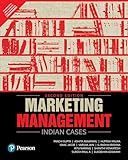 |
Learning Resource Centre Monthly Bulletin |
 |
 |
Learning Resource Centre Monthly Bulletin |
 |
| New Books |
 B119902 Marketing Management By Gupta Prachi |  B119721 B2B Marketing By Hutt Michael D |  B119718 Global Marketing Research By Kumar V |
| Click Here to learn about the Recent Books added to our collection on different topics of Management. |
| Articles |
| Marketing machines at work: performing e-commerce by assembling, adjusting, and maintaining a complex market device. By Fuentes, Christian;Stoopendahl, Patrik Journal of Marketing Management. Nov2025, Vol. 41 Issue 15/16, p1754-1778. 25p. Abstract :This paper aims to explore and conceptualise the marketing work of e-commerce managers. It draws on an ethnographically inspired study involving 21 e-commerce managers and approaches marketing work as a set of socio-material practices. The analysis shows that the marketing work of e-commerce managers centres on assembling, adjusting, and maintaining `marketing machines` – complex market devices designed to perform marketing work. These heterogeneous arrangements comprise digital technologies, staff and their competencies, and organisational procedures. When put together, these marketing machines work to calculate demand, develop a product assortment, advertise and promote products, sell and deliver products, and provide customer service. The paper concludes by discussing the implications of the device-focused analysis of marketing work for our understanding of the digitalisation of marketing. | |||
| Marketing`s boundary-work with IT in the digital age By Bourne, Clea Journal of Marketing Management. Nov2025, Vol. 41 Issue 15/16, p1706-1730. 25p. Abstract :This article examines how the global marketing profession sought new ways to ensure legitimacy and sustainability in the digital age by conjoining professional and managerial logics. Through field-level professional discourse analysis, the article examines marketing`s efforts to control the movement of increasingly fluid professional boundaries in the digital economy through jurisdictional boundary-work with the IT profession. The article uncovers professional marketers` efforts to: (1) regain `command and control` within organisations through protectionist, expansionary and hybridising discourses designed to build digital capital for the marketing profession through collaboration with IT; (2) formalise the emergence of marketing technology or `MarTech` as a new technology specialism reporting to marketing; and (3) assert new areas of control for marketing within the organisation. | |||
| Leveraging Nostalgia Marketing for Enhancing Emotional Connection with Brands and Purchase Intention: A Cross-Sectional Study By M, Jomon Jose; N, Thasleena IUP Journal of Brand Management; Hyderabad Vol. 22, Iss. 3, (Jul-Sep 2025): 5-21. DOI:10.71329/IUPJBRM/2025.22.3.5-21 Abstract :This study investigates how nostalgia marketing affects purchasing decisions in the Indian setting, with an emphasis on its psychological effects on emotional connection, brand loyalty and purchase intention. A questionnaire with a 5-point Likert scale was used to collect data from 450 Indian customers aged between 8 and 60 as part of a quantitative, cross-sectional design. The data was analyzed using SPSS PROCESS macro to investigate mediation and moderation effects, and the sample was balanced across gender, age (Gen Z, Millennials, Gen X), and urban/rural areas. The findings show that nostalgia marketing greatly improves emotional connection, which in turn mediates the association between nostalgia marketing and purchase intention. Urban respondents and older customers (Millennials, Gen X) react more strongly to nostalgic cues than do Gen Z and rural respondents. These results demonstrate how well nostalgia marketing works to increase consumer interaction in India`s online marketplace. Marketers may increase brand loyalty, especially among older and urban populations, using vintage motifs such as Bollywood-inspired advertisements. In order to overcome the drawbacks of cross-sectional design and convenience sampling, future studies should investigate longitudinal impacts and product-specific applications. | |||
| Do you wish to explore more articles? Just try using one of the full-text databases below! | |||
| Faculty - Click here to recommend new topics in Marketing |
| News |
| The vanishing human in customer care By Mint; Nov 12 2025 |
| Yamaha enters India`s EV market, to roll out 10 new models by end-2026 By Business Standard; Nov 11 2025 |
| Amazon Ads rolls out AI-powered video generator for Indian advertisers By The Economic Times; Nov 11 2025 |
Wish to see more News? Click the link below: |